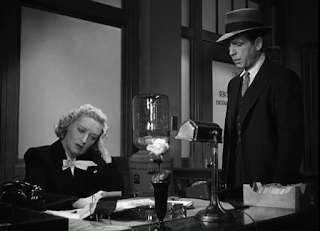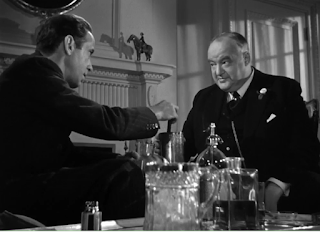Hammett's basic story is adhered to, though there are
some liberties taken now and again, and the seedier aspects
of the plot have been sanitized for 1940s audiences.
At one hundred minutes, this film is a good twenty minutes longer than any other screen adaptation of Dashiell Hammett's novel The Maltese Falcon. It's a fine film, more well-crafted than the two previous versions. As I've explained, the reason I chose the three Falcon adaptations to start this blog is that they pretty much encompass the 1930s Warner Bros/First National era for me. Almost every old movie I love came out of the Warner studios during that time frame. There are many, many of them. Bogart is in some of them, but other names will pop up. People like Barton MacLane, who played Inspector Dundy here. He was a Warner contract player who had been in bit parts as thugs and gangsters, but found himself in a genuine cinema classic here. He'd later work with Bogart and director John Huston again in 1948's The Treasure of the Sierra Madre, but that's not at all the type of film I'm going to cover here. You'll see him referenced mostly in his role as Steve McBride alongside Glenda Farrell in the Torchy Blane series. That's exactly my speed. I don't enjoy gritty realism and darkness in movies. If I want realism, I'll stand up and go outside.
Jerome Cowan, using visual cues to project his horniness, plays
it sleazy as Spade's partner Archer and is quickly killed off.
The plot, though tweaked just a bit, is pretty much the same as the original Maltese Falcon in 1931 and Satan Met a Lady in 1936: mystery lady visits the private detective's office with a phony story, detective's partner gets killed trying to help her, turns out there's a weird object that everyone is looking for, then the mystery lady's story changes again, police try to shake down the private eye, the object is recovered, it turns out to be fake, and the mystery lady ends up being turned in for the murder by the private eye, even though he loved her. I know, right? It's that simple, and not that simple.
Barton MacLane (left), who'll be better known for his roles in the
Torchy Blane films here, is Inspector Dundy to Ward Bond's Sgt. Polhaus.
Bond (right) was the lead in Wagon Train until his death in 1960.
He also portrayed Bert the cop in It's a Wonderful Life.
He also portrayed Bert the cop in It's a Wonderful Life.
These were more moral times, owing to the self-enforced movie production code, and changes were made. Sam makes one fleeting reference to Dundy being Polhaus' "boyfriend" in the 1941 version, and I think that was more strongly implied in the novel and earlier film. Also, Joel Cairo's probable homosexuality is toned down to him wearing sweet-smelling perfume. The scene in the 1931 version where Spade forces Ruth to strip is completely gone. Any indication that they slept together is glossed over. Ruth doesn't seem to be as bad of a two-faced whore as she was in 1931, either. She's more sympathetic, and her character softened. The movie couldn't have been made if it wasn't. There is no, and I mean no, sexual tension between Spade and his secretary Effie. This was a radical departure from the previous filmed versions. Perhaps it was because she wasn't wearing the same sexy dresses they were. They were just asking for it, you know? Come on, tell me you know. I'll wait.
Lee Patrick as a very weak Effie Perrine. She and Sam Spade have no
sexual chemistry whatsoever. This might be due to studio censorship.
Samuel Spade in The Maltese Falcon (1941), Rick Blaine in Casablanca (1942), and Philip Marlowe in The Big Sleep (1946) are all very different characters, and that's the only problem, if any, I have with Bogart. He plays them exactly the same way. Bogart was a move star, and probably the biggest movie star, of his time. He was going to do his thing, and he wasn't really going to go outside those boundaries. I love all these movies, mind you, but I know that's not the way they were written. It's hard not to think of Bogart in these roles. There was a very popular Sam Spade radio series in the 1940s with Howard Duff, and he didn't even bother to try and imitate Bogart. It was self-referential and mostly played for laughs. Bogart could act, though, as demonstrated in The African Queen (1951) and The Caine Mutiny (1954).
Gladys George as Iva Archer. She greets Spade with a kiss on the lips
following the death of her husband. Their affair is not mentioned.
It's a good film...some would say a great film, sure. It is stylish and does convey the story in an effective manner. It's certainly more well-made than the two previous versions, no doubt about that. But it's very much a thing of its time. It's a story much more raw than the standards of the time would permit on the screen, so the end product is subdued. It's a pretty sexy and violent tale, but you wouldn't know that simply by watching the movie.
Now, there is a sequel. Or more than one sequel, depending on your belief system. In the original story (and don't quote me on this), hired gunsel Wilmer (Elisha Cook, Jr.) shoots both Joel Cairo and Kaspar Gutman dead before they can be arrested. This wasn't referred to in the 1941 version, so the implication is that they got away. With this in mind, there was a fairly silly Sam Spade radio episode in which Gutman returned. In 1975, Columbia released The Black Bird, a parody sequel starring George Segal as Sam Spade, Jr. Elisha Cook, Jr. and Lee Patrick both appeared, reprising their roles from the 1941 version. I have not seen it. The sad part is, I think I actually have it, and I haven't seen it. Life is too short.
It's more strongly implied in the novel that Cairo and Gutman
are homosexuals. In this film the cues are all visual, as
Cairo fondles the umbrella in a highly suggestive manner.
Humphrey Bogart died in 1957 of esophageal cancer. Peter Lorre died in 1964 from a stroke. Ward Bond died in 1960 of a sudden heart attack while Wagon Train was still a huge hit on TV. Sydney Greenstreet died in 1954 from diabetes and kidney disease. When Barton MacLane died of pneumonia on New Year's Day, 1969, he had a recurring role on I Dream of Jeannie. Three of his episodes were broadcast after his death. Elisha Cook Jr., who played Wilmer, died in 1995 from a stroke at age 91. Gladys George died from a cerebral hemorrhage in 1954. Lee Patrick died in 1982 of a heart seizure. Mary Astor lived until 1987. A heavy smoker, director John Huston died from pneumonia brought on by emphysema in 1987. Don't ask me why I dwell so much on the deaths of movie stars. Not a clue. I have not a clue.
An Oscar-nominated performance by British actor Sydney
Greenstreet as Kasper Gutman. He soon appeared as Signor
Ferrari in the 1942 Bogart classic Casablanca.







No comments:
Post a Comment